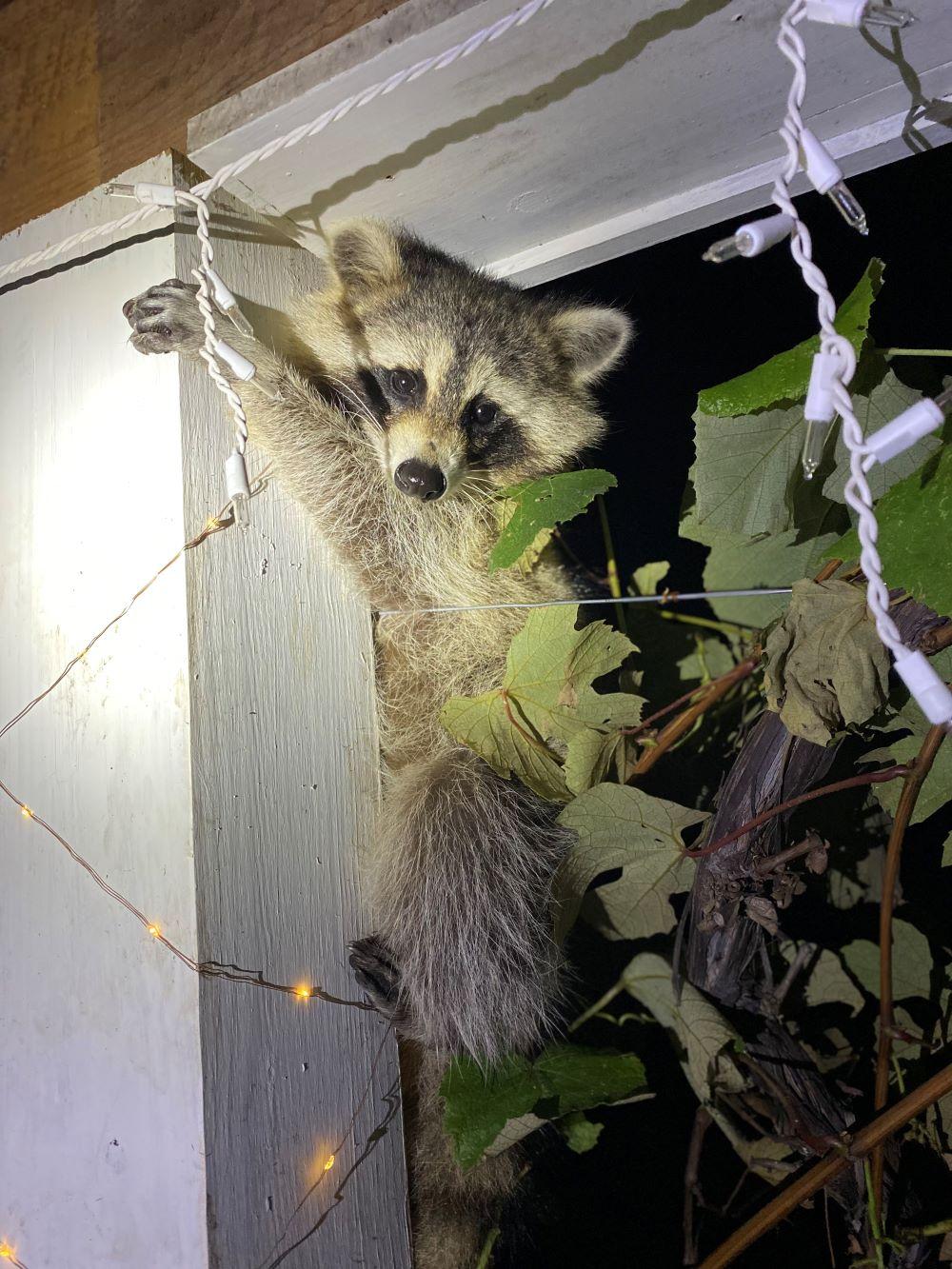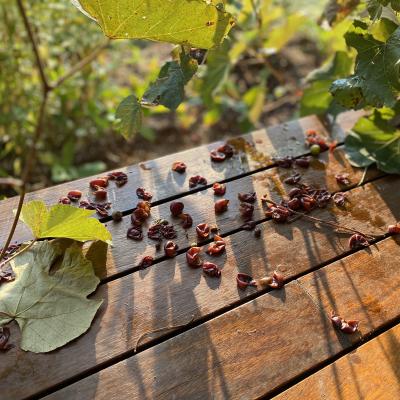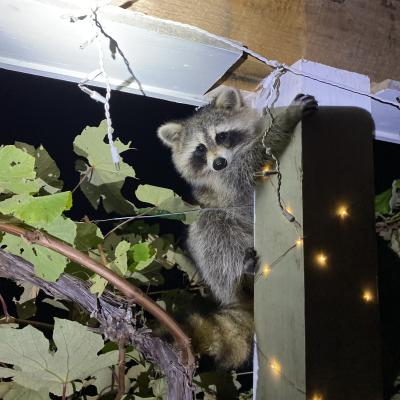Wildlife feasting, fattening on seasonal autumnal abundance of fruits and nuts.
- Tags:
- Wildlife,
- Forest Journal

This raccoon was caught red-handed among the grape vines.
Autumn Cornucopia?
After poor natural food crops for wildlife in both 2021 and ’22, this year has been a bonanza despite commercial apple crops affected by the late frost in May which also frosted oak and beech leaves at lower elevations. This summer’s rains have fruits and autumn seeds of many forest trees: oaks, beech, hickory, hazelnut shrubs – and waxy fall berries of wetland shrubs and ornamental landscaping including crabapples - yielding a bumper crop for birds and wildlife.
In early October, Concord grapes on shady vines growing along my front porch had ripened. That sweet-musky scent is reminiscent of grape jam. That distinctive smell also attracts nocturnal wildlife – mysterious night visitors including opossums, skunks or raccoons that shuffle away before I catch more than a fleeting glimpse.

Many mammals are attracted to grapes in autumn: black bears, gray and red foxes and squirrels. Rabbits and deer browse grape foliage, stems and young vines. But few of these mammals climb. Fruit-eating birds including robins, catbirds, waxwings and cardinals consume some wild grapes. I was unsure who had been eating my grapes and leaving tough purple grape skins behind… Until a few weeks ago when I began drinking with a raccoon.
I was enjoying a California Cabernet Sauvignon; the raccoon favored the NH Concord grape 2023. I investigated the peculiar sound of bouncing grapes while the raccoon scaled a porch post and hid in the eaves between rafters. It was soon asleep and snoring. Later I realized the grapes had naturally fermented and ripened past peak. Raccoon grew tipsy and sleepy. Perhaps I did too? It was all a little hazy the next morning when grape skins littered the porch.

During the next visit, raccoon deftly plucked and squeezed pulp and seeds into its mouth. The morning mystery of discarded grape skins now solved. Raccoon obliged me by posing for portraits wholly unafraid. It was not interested in audio I played via Bluetooth speakers from my phone: I found a You-Tube recording entitled “raccoons talking.” I have no idea what they were saying. I selected “cooing” and “chittering” which seemed a better choice than the growling and screeching options. I’ve since learned raccoons can make more than two hundred different sounds.
Once the last grapes were harvested, raccoon and its single companion ceased to visit. The last time I saw the pair of masked bandits, they fled in fear of my flashlight. Seems the better timing is last call – after they imbibe sufficiently to lose their inhibitions. Party animals.

Raccoons are cute: black masks, expressive eyes, fuzzy ears, dexterous paws and jaunty bushy striped tails a squirrel would envy. Raccoon dispositions are described as clever, intelligent and occasionally fierce. In autumn, raccoons eat as much as possible to build winter fat reserves. Raccoons may burn 50% of their stored fat to remain alive in winter when food is scarce. Other mammals – notably rodents including chipmunks, red and gray squirrels cache autumn conifer cones, maple and ash seeds, acorns and beech nuts, and dried mushrooms while storing food to get through their winter. Raccoons – like black bears – store food in the form of body fat reserves.
Akin to bears, raccoons do not truly hibernate but enter a state of prolonged winter torpor when temperatures drop below fifteen degrees, often sharing communal dens of several raccoons often for weeks at a time in hollow trees, fallen logs, beneath stumps and beneath barns, garages, porches or in attics and in unused chimneys. They must wake up occasionally during winter to restore their metabolism, forage and drink water. Yet little food is available in winter. Fat-rich fall forest foods include acorns, hickory nuts, beechnuts and hazelnuts – all are plentiful this year in NH. Raccoons forage for insects: yellow jacket larvae, bumble bees and honey bees and their honey. Trees may yield sleeping mice or bats. Raccoon swim in late summer and early autumn when pond and wetland habitats provide fish, frogs, crayfish and mussels. They are eating machines!
Some people think of raccoons like small bears which they are not. Raccoons are most closely related to Coatis and Kinkajous. Like bears and porcupines, raccoons have a broad chest to facilitate climbing. They all walk flat-footed instead of on tippy toes like cats and dogs which give them all a distinctive waddling gait. They can all stand upright on back legs and pivot from their hips.

“Foxiness”
The scent of wild Concord grapes is a highway sign signaling fast food - sweetness, flavor and aroma – described as “the archetypal American grape.” Mammals ingest grape seeds and redeposit them in their scat – an ingenious method for dispersing grapes seeds to far-flung sunny field and forest edges. The chemical responsible for the strong grape aroma is methyl anthranilate - also found in flowers of black locust, orange and jasmine. Wild grapes ripening in clusters on vines are THE perfume of sunny autumn eastern woodlands. A sweet scent that makes up for a sour taste.
In fact the scent of many grape varieties is described as “foxiness.” That earthy scent is said to be a natural bird repellent. “Sour grapes” is the Aesop’s fable of a fox that could not reach the hanging fruits. But that still doesn’t account for the name.
A farmer-friend, Bart Hunter once managed May Hill Vineyard in Weare, NH. He relates a tale shared by an “enologist” (a wine grape expert) at a Canadian symposium. The grape expert had toured a lab in Germany where he smelled wild grapes. He asked scientists what their grape research entailed and they were confused. They were researching fox urine from commercial fur farming operations. When the grape expert returned home, he tested samples of grape and fox pee scent and found only one molecule difference between fox and grape. Therein – somewhere - lies the origin of “foxiness” of grapes.
Much easier to say than “Raccooniness.”
